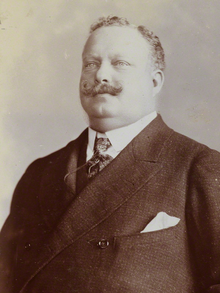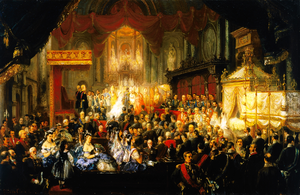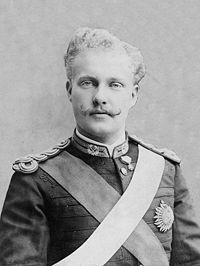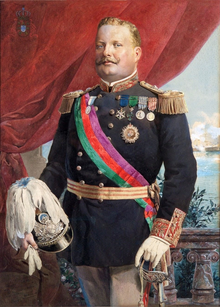This is an old revision of this page, as edited by 2405:9800:bc30:1f37:d5f5:85b2:fa37:5b9b (talk) at 13:16, 24 November 2023. The present address (URL) is a permanent link to this revision, which may differ significantly from the current revision.
Revision as of 13:16, 24 November 2023 by 2405:9800:bc30:1f37:d5f5:85b2:fa37:5b9b (talk)(diff) ← Previous revision | Latest revision (diff) | Newer revision → (diff) King of Portugal from 1889 to 1908You can help expand this article with text translated from the corresponding article in Portuguese. (January 2012) Click for important translation instructions.
|
| This article includes a list of general references, but it lacks sufficient corresponding inline citations. Please help to improve this article by introducing more precise citations. (January 2010) (Learn how and when to remove this message) |
| Carlos I | |
|---|---|
 Photograph c. 1907 Photograph c. 1907 | |
| King of Portugal | |
| Reign | 19 October 1889 – 1 February 1908 |
| Acclamation | 28 December 1889 |
| Predecessor | Luís I |
| Successor | Luís IIor Manuel II |
| Prime Ministers | See list |
| Born | 28 September 1863 Ajuda Palace, Lisbon, Portugal |
| Died | 1 February 1908 (aged 44) Terreiro do Paço, Lisbon, Portugal |
| Burial | Pantheon of the Braganzas |
| Spouse |
Amélie of Orléans (m. 1886) |
| Issue |
|
| House | Braganza |
| Father | Luís I |
| Mother | Maria Pia of Savoy |
| Religion | Roman Catholicism |
| Signature | |
Dom Carlos I (Template:IPA-pt; Charles; 28 September 1863 – 1 February 1908), known as the Diplomat (Template:Lang-pt), the Martyr (Template:Lang-pt), and the Oceanographer (Template:Lang-pt), among many other names, was King of Portugal from 1889 until his assassination in 1908. He was the first Portuguese king to die a violent death since King Sebastian in 1578.
Early life


Carlos was born in Lisbon, Portugal, the son of King Luís and Queen Maria Pia, daughter of King Victor Emmanuel II of Italy, and was a member of the House of Braganza. He had a brother, Infante Afonso, Duke of Porto. He was baptised with the names Carlos Fernando Luís Maria Víctor Miguel Rafael Gabriel Gonzaga Xavier Francisco de Assis José Simão.
He had an intense education and was prepared to rule as a constitutional monarch. In 1883, he traveled to Italy, the United Kingdom, France and Germany, where he increased his knowledge of the modern civilization of his time. In 1883, 1886 and 1888, he ruled as Regent as his father was traveling in Europe, as had become traditional among the Portuguese constitutional kings. His father Luis I advised him to be modest and to study with focus.
His first bridal candidate was one of the daughters of German Emperor Frederick III, but the issue of religion presented an insurmountable problem, and diplomatic pressure from the British government prevented the marriage. He then met and married Princess Amélie of Orléans, eldest daughter of Philippe, comte de Paris, pretender to the throne of France.
Reign

Carlos became king on 19 October 1889. After the 1890 British Ultimatum, a series of treaties were signed with the United Kingdom. One signed in August 1890 defined colonial borders along the Zambezi and Congo rivers, whereas another signed on 14 October 1899 confirmed colonial treaties dating back to the 17th century. These treaties stabilised the political balance in Africa, ending Portuguese claims of sovereignty on the Pink Map, a geographical conception of how Portuguese colonies would appear on a map if the territory between the coastal colonies of Angola and Mozambique could be connected with territory in central Africa. These central African territories became part of the British Empire with the Portuguese concession becoming a source of national resentment in the country.
Domestically, Portugal declared bankruptcy twice – on 14 June 1892, then again on 10 May 1902 – causing industrial disturbances, socialist and republican antagonism and press criticism of the monarchy. Carlos responded by appointing João Franco as prime minister and subsequently accepting parliament's dissolution.
As a patron of science and the arts, King Carlos took an active part in the celebration of the 500th anniversary of the birth of Prince Henry the Navigator in 1894. The following year he decorated the Portuguese poet João de Deus in a ceremony in Lisbon.
Carlos took a personal interest in deep-sea and maritime exploration and used several yachts named Amélia on his oceanographical voyages. He published an account of his own studies in this area.
Assassination
Main article: Lisbon Regicide
On 1 February 1908, the royal family was returning to Lisbon from the Ducal Palace of Vila Viçosa in Alentejo, where they had spent part of the hunting season during the winter. They traveled by train to Barreiro and, from there, they took a steamer to cross the Tagus River and disembarked at Cais do Sodré in central Lisbon. On their way to the royal palace, the open carriage with Carlos I and his family passed through the Terreiro do Paço fronting on the river. In spite of recent political unrest there was no military escort. While they were crossing the square at dusk, shots were fired from amongst the sparse crowd by two republican activists, Alfredo Luís da Costa and Manuel Buíça.
Buíça, a former army sergeant and sharpshooter, fired five shots from a rifle hidden under his long overcoat. The king died immediately, his heir Luís Filipe was mortally wounded, and Prince Manuel was hit in the arm. The queen escaped injury. The two assassins were killed on the spot by police, and an innocent bystander, João da Costa, was also shot dead in the confusion. The royal carriage turned into the nearby Navy Arsenal, where, about twenty minutes later, Prince Luís Filipe died. Several days later, the younger son, Prince Manuel, was proclaimed king of Portugal. He was the last of the Braganza-Saxe-Coburg and Gotha dynasty and the final king of Portugal.
Marriage and children

Carlos I was married to Princess Amélie of Orléans in 1886. She was a daughter of Philippe, Count of Paris, and Princess Marie Isabelle of Orléans. Their children were:
- Luís Filipe, Prince Royal of Portugal (1887–1908)
- Infanta Maria Ana of Braganza (b/d December 14, 1887)
- Manuel II, King of Portugal between 1908 and 1910 (1889–1932)
A woman known as Maria Pia of Saxe-Coburg and Braganza claimed to be the illegitimate daughter of King Carlos I of Portugal with Maria Amélia Laredó e Murça. Maria Pia claimed that King Carlos I legitimized her through a royal decree and placed her in the line of succession with the same rights and honours as the legitimately-born princes of Portugal; however, no undisputed evidence was presented to demonstrate this, and the king did not, constitutionally, have the personal authority to do so. Maria Pia's paternity was never proven and her claim not widely accepted.
Honours
- Portuguese
- Grand Commander of the Three Military Orders of Christ, Aviz and St. James
- Grand Cross of the Tower and Sword
- Grand Cross of the Immaculate Conception of Vila Viçosa
- Foreign

 Austria-Hungary: Grand Cross of the Royal Hungarian Order of St. Stephen, 1873
Austria-Hungary: Grand Cross of the Royal Hungarian Order of St. Stephen, 1873 Empire of Brazil: Grand Cross of the Southern Cross, 1873
Empire of Brazil: Grand Cross of the Southern Cross, 1873 Denmark: Knight of the Elephant, 7 October 1883
Denmark: Knight of the Elephant, 7 October 1883 German Empire:
German Empire:
- Knight of the Black Eagle, 10 September 1883
- Grand Cross of the Red Eagle


 Ernestine duchies: Grand Cross of the Saxe-Ernestine House Order, 1884
Ernestine duchies: Grand Cross of the Saxe-Ernestine House Order, 1884 Hesse and by Rhine: Grand Cross of the Ludwig Order, 24 September 1883
Hesse and by Rhine: Grand Cross of the Ludwig Order, 24 September 1883 Saxe-Weimar-Eisenach: Grand Cross of the White Falcon, 1883
Saxe-Weimar-Eisenach: Grand Cross of the White Falcon, 1883 Saxony: Knight of the Rue Crown, 1883
Saxony: Knight of the Rue Crown, 1883
 Kingdom of Italy:
Kingdom of Italy:
- Knight of the Annunciation, 31 December 1873
- Grand Cross of Saints Maurice and Lazarus, 31 December 1873
- Grand Cross of the Crown of Italy, 31 December 1873
 Holy See: Grand Cross of the Holy Sepulchre of Jerusalem
Holy See: Grand Cross of the Holy Sepulchre of Jerusalem Sovereign Military Order of Malta: Bailiff Grand Cross of Honour and Devotion
Sovereign Military Order of Malta: Bailiff Grand Cross of Honour and Devotion Empire of Japan: Grand Cordon of the Order of the Chrysanthemum, 5 June 1897
Empire of Japan: Grand Cordon of the Order of the Chrysanthemum, 5 June 1897 Kingdom of Romania: Grand Cross of the Order of Carol I, with Collar, 1906
Kingdom of Romania: Grand Cross of the Order of Carol I, with Collar, 1906 Siam: Knight of the Order of the Royal House of Chakri, 23 October 1897
Siam: Knight of the Order of the Royal House of Chakri, 23 October 1897 Kingdom of Spain:
Kingdom of Spain:
- Knight of the Golden Fleece, 11 December 1866
- Grand Cross of the Order of Charles III, with Collar, 12 December 1902

 Sweden-Norway:
Sweden-Norway:
- Knight of the Seraphim, 23 May 1873
- Grand Cross of St. Olav, 11 October 1883
 United Kingdom:
United Kingdom:
- Stranger Knight Companion of the Garter, 9 November 1895
- Recipient of the Royal Victorian Chain, 19 November 1902
 Russian Empire:
Russian Empire:
Ancestry
| Ancestors of Carlos I of Portugal |
|---|
Citations
- ^ "While remaining patrilineal dynasts of the duchy of Saxe-Coburg and Gotha according to pp. 88, 116 of the 1944 Almanach de Gotha, Title 1, Chapter 1, Article 5 of the 1838 Portuguese constitution declared, with respect to Ferdinand II of Portugal's issue by his first wife, that 'the Most Serene House of Braganza is the reigning house of Portugal and continues through the Person of the Lady Queen Maria II'. Thus their mutual descendants constitute the Coburg line of the House of Braganza"
- Saldanha, Luiz (1997). One Hundred Years of Portuguese Oceanography: In the Footsteps of King Carlos de Bragança. Setúbal: Museu Bocage, Museu Nacional de História Natural. p. 196.
- "Carlos I (Rei D.)". Centro de Estudos de Sociologia e Estética Musical. Fundação da Casa de Bragança. Retrieved 20 February 2022.
- Newton, Michael (2014). Famous Assassinations in World History: An Encyclopedia. Santa Barbara, California, USA: ABC-CLIO. p. 73. ISBN 978-1610692861. Retrieved 20 February 2022.
- ^ Chisholm, Hugh, ed. (1911). "Carlos I." . Encyclopædia Britannica. Vol. 5 (11th ed.). Cambridge University Press.
- Newitt, Malyn (12 November 2019). The Braganzas. Reaktion Books, Limited. p. 284. ISBN 978-1-78914-125-2.
- de Castro, Anibal Pinto (2008). O Regicidio de 1908. Civilização Editora. pp. 111 & 120. ISBN 978-972-26-2677-4.
- de Castro, Anibal Pinto (2008). O Regicidio de 1908. Civilização Editora. pp. 132–133. ISBN 978-972-26-2677-4.
- "Princess Maria Pia of Saxe-Coburg, Duchess of Braganza" in CHILCOTE, Ronald H.; The Portuguese Revolution: State and Class in the Transition to Democracy, page 37. Rowman & Littlefield Publishers; Reprint edition (31 August 2012).
- "...Her Royal Highness D. Maria Pia of Saxe-Coburg and Gotha Braganza, the Crown Princess of Portugal" in Jean Pailler; Maria Pia of Braganza: The Pretender. New York: ProjectedLetters, 2006;
- ^ Albano da Silveira Pinto (1883). "Serenissima Casa de Bragança". Resenha das Familias Titulares e Grandes des Portugal (in Portuguese). Lisbon: Lisboa F.A. da Silva. p. xv.
- "A Szent István Rend tagjai" Archived 22 December 2010 at the Wayback Machine
- Jørgen Pedersen (2009). Riddere af Elefantordenen, 1559–2009 (in Danish). Syddansk Universitetsforlag. p. 468. ISBN 978-87-7674-434-2.
- "Schwarzer Adler-orden", Königlich Preussische Ordensliste (in German), vol. 1, Berlin, 1886, p. 9
{{citation}}: CS1 maint: location missing publisher (link) - Staatshandbücher für das Herzogtum Sachsen-Coburg und Gotha (1890), "Herzogliche Sachsen-Ernestinischer Hausorden" p. 43
- "Ludewigs-orden", Großherzoglich Hessische Ordensliste (in German), Darmstadt: Staatsverlag, 1907, p. 7
- Staatshandbuch für das Großherzogtum Sachsen / Sachsen-Weimar-Eisenach Archived 6 September 2020 at the Wayback Machine (1900), "Großherzogliche Hausorden" p. 16
- Sachsen (1901). "Königlich Orden". Staatshandbuch für den Königreich Sachsen: 1901. Dresden: Heinrich. p. 4 – via hathitrust.org.
- Italia : Ministero dell'interno (1898). Calendario generale del Regno d'Italia. Unione tipografico-editrice. p. 54.
- ^ Justus Perthes, Almanach de Gotha (1908) p. 66
- 刑部芳則 (2017). 明治時代の勲章外交儀礼 (PDF) (in Japanese). 明治聖徳記念学会紀要. p. 149.
- "Ordinul Carol I" [Order of Carol I]. Familia Regală a României (in Romanian). Bucharest. Retrieved 17 October 2019.
- Royal Thai Government Gazette (11 June 1899). "พระราชทานเครื่องราชอิสริยาภรณ์ที่ประเทศยุโรป (ต่อแผ่นที่ ๑๐ หน้า ๑๓๖)" (PDF) (in Thai). Archived from the original (PDF) on 4 March 2016. Retrieved 8 May 2019.
{{cite journal}}: Cite journal requires|journal=(help) - "Caballeros de la insigne orden del toisón de oro", Guía Oficial de España (in Spanish), 1908, p. 152, retrieved 15 December 2019
- "Real y distinguida orden de Carlos III", Guía Oficial de España (in Spanish), 1908, p. 156, retrieved 15 December 2019
- Sveriges statskalender (in Swedish), 1905, p. 440, retrieved 6 January 2018 – via runeberg.org
- Norges Statskalender (in Norwegian), 1890, pp. 595–596, retrieved 6 January 2018 – via runeberg.org
- Shaw, Wm. A. (1906) The Knights of England, I, London, p. 70
- Shaw, p. 416
General references
- Jean Pailler: D. Carlos I – Rei de Portugal: Destino Maldito de um Rei Sacrificado. Bertrand, Lisbon, 2001, ISBN 978-972-25-1231-2
- Jean Pailler: Maria Pia: A Mulher que Queria Ser Rainha de Portugal. Bertrand, Lisbon, 2006, ISBN 972-25-1467-9
- Manuel Amaral: Portugal – Dicionário Histórico, Corográfico, Heráldico, Biográfico, Bibliográfico, Numismático e Artístico, Volume II, 1904–1915, págs. 759
- Rui Ramos: D. Carlos, Temas e Debates, Lisbon, 2007.
- New York Times: February 2 ,1908 Issue https://timesmachine.nytimes.com/timesmachine/1908/02/02/issue.html
| Carlos I of Portugal House of BraganzaCadet branch of the House of AvizBorn: 28 September 1863 Died: 1 February 1908 | ||
| Regnal titles | ||
|---|---|---|
| Preceded byLuís I | King of Portugal 19 October 1889 – 1 February 1908 |
Succeeded byManuel II |
| Portuguese royalty | ||
| Preceded byPedro V | Prince Royal of Portugal 28 September 1863 – 19 October 1889 |
Succeeded byLuís Filipe |
| Duke of Braganza 28 September 1863 – 19 October 1889 | ||
| Monarchs of Portugal | ||
|---|---|---|
| House of Burgundy (1139–1383) |  | |
| House of Aviz (1385–1580) | ||
| House of Habsburg (1581–1640) | ||
| House of Braganza (1640–1910) | ||
| Debatable or disputed rulers are in italics. | ||
| Dukes of Braganza | ||
|---|---|---|
| Feudal Dukes |  | |
| Heir to the Throne | ||
| Claimant to the Throne | ||
| Infantes of Portugal | |
|---|---|
| The generations indicate descent from Afonso I, and continues through the House of Aviz, the House of Habsburg through Infanta Isabel, Holy Roman Empress and Queen of Spain, and the House of Braganza through Infanta Catarina, Duchess of Braganza. | |
| 1st generation | |
| 2nd generation | |
| 3rd generation | |
| 4th generation | |
| 5th generation | |
| 6th generation | |
| 7th generation | |
| 8th generation | |
| 9th generation | |
| 10th generation | |
| 11th generation | |
| 12th generation | |
| 13th generation | |
| 14th generation | |
| 15th generation | |
| 16th generation | |
| 17th generation | |
| 18th generation |
|
| 19th generation | |
| 20th generation | |
| 21st generation | |
| 22nd generation | |
| 23rd generation | |
| 24th generation | |
| * also an infante of Castile and León, Aragon, Sicily and Naples, § also an infante of Spain and an archduke of Austria, # also an infante of Spain, ‡ also an imperial prince of Brazil, ¶ also a prince of Saxe-Coburg and Gotha, Duke in Saxony, ◙ also a prince of Braganza, ¤ title removed in 1920 as their parents' marriage was deemed undynastic, ƒ claimant infante | |
| House of Braganza-Saxe-Coburg and Gotha | ||
|---|---|---|
| 1st generation |
|  |
| 2nd generation | ||
| 3rd generation |
| |
| The House of Saxe-Coburg and Braganza was not a recognized house in the former Kingdom of Portugal and monarchs following Maria II and Ferdinand II officially continued to be members of the House of Braganza | ||
| Princes of Saxe-Coburg and Gotha | |||||||||||||
|---|---|---|---|---|---|---|---|---|---|---|---|---|---|
| Forefather | Duke Francis I* | ||||||||||||
| 1st generation | |||||||||||||
| 2nd generation |
| ||||||||||||
| 3rd generation |
| ||||||||||||
| 4th generation |
| ||||||||||||
| 5th generation |
| ||||||||||||
| 6th generation |
| ||||||||||||
| 7th generation |
| ||||||||||||
| *Titled as Princes of Saxe-Coburg-Saalfeld before 11 February 1826 | |||||||||||||
- 1863 births
- 1908 murders in Portugal
- 1908 deaths
- 19th-century Portuguese monarchs
- 20th-century murdered monarchs
- 20th-century Portuguese monarchs
- Assassinated Portuguese people
- Burials at the Monastery of São Vicente de Fora
- Deaths by firearm in Portugal
- Dukes of Braganza
- Extra Knights Companion of the Garter
- Grand Crosses of the Order of Aviz
- Grand Crosses of the Order of Christ (Portugal)
- Grand Crosses of the Order of Saint James of the Sword
- Grand Crosses of the Order of Saint Stephen of Hungary
- House of Braganza-Saxe-Coburg and Gotha
- Knights Grand Cross of the Order of the Immaculate Conception of Vila Viçosa
- Knights of the Golden Fleece of Spain
- Knights of the Holy Sepulchre
- Oceanographers
- Nobility from Lisbon
- People murdered in Portugal
- Portuguese people of Italian descent
- Portuguese royalty
- Portuguese Roman Catholics
- Princes Royal of Portugal
- Recipients of the Order of St. Anna, 1st class
- Recipients of the Order of the White Eagle (Russia)